机械类专业英语课文参考翻译
- 格式:pdf
- 大小:673.26 KB
- 文档页数:65
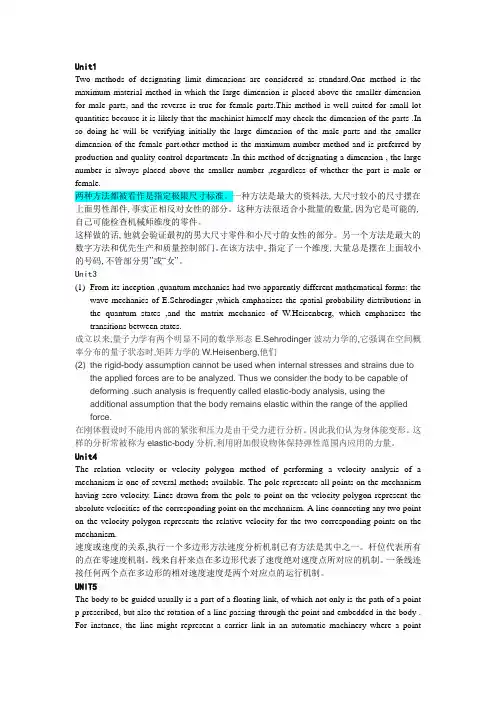
Unit1Two methods of designating limit dimensions are considered as standard.One method is the maximum material method in which the large dimension is placed above the smaller dimension for male parts, and the reverse is true for female parts.This method is well suited for small lot quantities because it is likely that the machinist himself may check the dimension of the parts .In so doing he will be verifying initially the large dimension of the male parts and the smaller dimension of the female part.other method is the maximum number method and is preferred by production and quality control departments .In this method of designating a dimension , the large number is always placed above the smaller number ,regardless of whether the part is male or female.两种方法都被看作是指定极限尺寸标准。
一种方法是最大的资料法,大尺寸较小的尺寸摆在上面男性部件,事实正相反对女性的部分。
![机械工程专业英语教程(第2版)[施平主编][翻译]_lesson1](https://uimg.taocdn.com/5728f673a417866fb84a8e09.webp)
Basic Concept in MechanicsThe branch of scientific analysis which deals with motions , time , and forces is called mechanics and is made up of two parts , statics and dynamics , Statics deals with the analysis of stationary systems , i.e. , those in which time is not a factor , and dynamics deals with systems which change with time .对运动、时间和作用力做出科学分析的分支称为力学。
它由静力学和动力学两部分组成。
静力学对静止系统进行分析,即在其中不考虑时间这个因素,动力学对随时间而变化的系统进行分析。
When a number of bodies are connected together to form a group or system , the forces of action and reaction between any two of the connecting bodies are called constraint forces . These forces constrain the bodies to behave in a specific manner . Forces external to this system of bodies are called applied forces .当一些物体连接在一起形成一个组合体或者系统时,任何两个相连接的物体之间的作用力和反作用力被称为约束力。
这些力约束着各个物体,使其处于特定的状态。
从外部施加到这个物体的系统的力被称为外力。
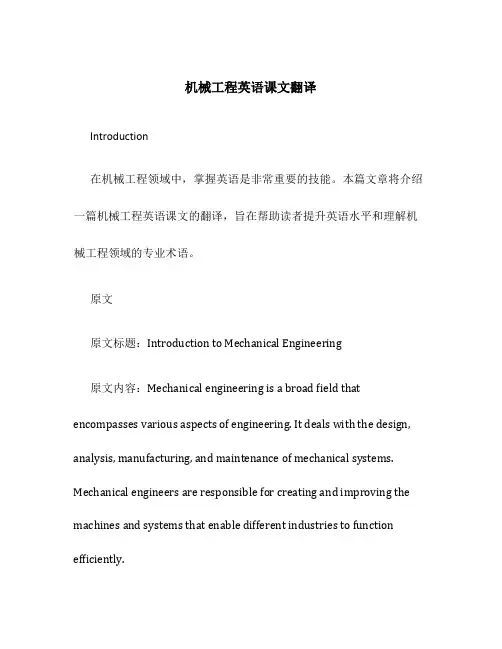
机械工程英语课文翻译Introduction在机械工程领域中,掌握英语是非常重要的技能。
本篇文章将介绍一篇机械工程英语课文的翻译,旨在帮助读者提升英语水平和理解机械工程领域的专业术语。
原文原文标题:Introduction to Mechanical Engineering原文内容:Mechanical engineering is a broad field that encompasses various aspects of engineering. It deals with the design, analysis, manufacturing, and maintenance of mechanical systems. Mechanical engineers are responsible for creating and improving the machines and systems that enable different industries to function efficiently.The field of mechanical engineering has a long history, dating back to ancient civilizations such as the Greeks and Egyptians. However, it wasn’t until the Industrial Revolution in the 18th century that mechanical engineering became a distinct discipline. This period saw the rise of factories and the need for efficient machines to drive industrial processes.Modern mechanical engineers work on a wide range of projects, from designing and constructing buildings to developing advanced robotics and aerospace systems. They utilize their knowledge of physics, mathematics, and materials science to analyze and solve complex engineering problems.翻译翻译标题:机械工程导论机械工程是一个包含各个工程学科的广泛领域。

机械工程专业英语第二版必考翻译(完整版)————————————————————————————————作者:————————————————————————————————日期:1.With low-power machinery or vehicles the operator can usually apply sufficient force through a simple mechanical linkage from the pedle or handle to the stationary part of the brake. In many cases, however, this force must be multiplied by using an elaborate braking system.(P5)用低能机器或传力工具,操作者通过向踏板或把手的一个简单机械连接构件作用足够的力量到车闸固定的部分。
大多数情况,然而,用一个详细(复杂)的车闸系统使这个力量成倍增加。
2. The fundamental principle involved is the use of compressed air acting through a piston in a cylinder to set block brakes on the wheels. The action is simultaneous on the wheels of all the cars in the train. The compressed air is carried through a strong hose from car to car with couplings between cars; its release to all the separate block brake units, at the same time, is controlled by the engineer. (Braking Systems)(P5)相关的基本原理是使用压缩气体,通过气缸内的活塞将闸块压在车轮起作用。
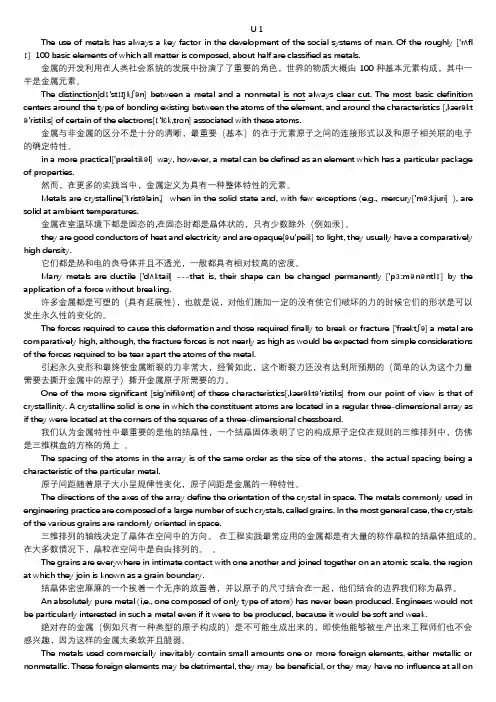
U 1The use of metals has always a key factor in the development of the social systems of man. Of the roughly ['rʌfl ɪ] 100 basic elements of which all matter is composed, about half are classified as metals.金属的开发利用在人类社会系统的发展中扮演了了重要的角色,世界的物质大概由100种基本元素构成,其中一半是金属元素。
The distinction[dɪ'stɪŋkʃən] between a metal and a nonmetal is not always clear cut. The most basic definition centers around the type of bonding existing between the atoms of the element, and around the characteristics [,kærəkt ə'ristiks] of certain of the electrons[ɪ'lɛk,trɑn] associated with these atoms.金属与非金属的区分不是十分的清晰,最重要(基本)的在于元素原子之间的连接形式以及和原子相关联的电子的确定特性。
in a more practical['præktikəl] way, however, a metal can be defined as an element which has a particular package of properties.然而,在更多的实践当中,金属定义为具有一种整体特性的元素。
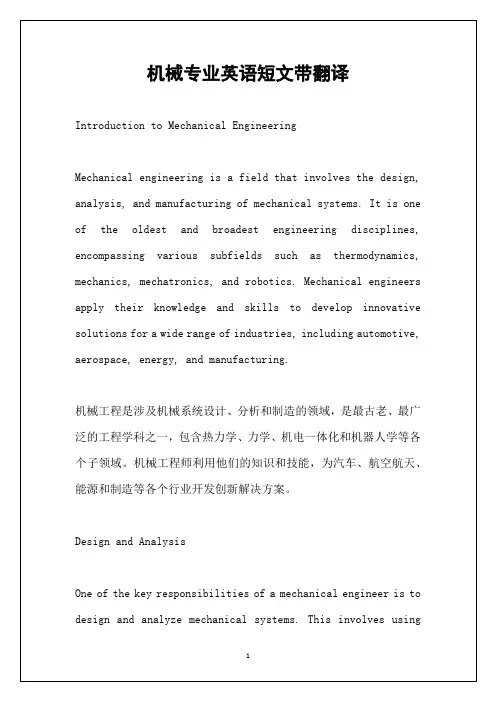
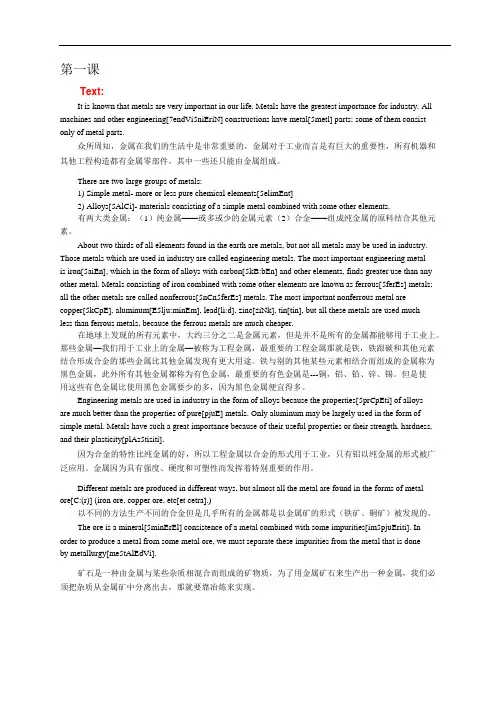
第一课Text:It is known that metals are very important in our life. Metals have the greatest importance for industry. All machines and other engineering[7endVi5niEriN] constructions have metal[5metl] parts; some of them consist only of metal parts.众所周知,金属在我们的生活中是非常重要的,金属对于工业而言是有巨大的重要性,所有机器和其他工程构造都有金属零部件,其中一些还只能由金属组成。
There are two large groups of metals:1) Simple metal- more or less pure chemical elements[5elimEnt]2) Alloys[5AlCi]- materials consisting of a simple metal combined with some other elements.有两大类金属:(1)纯金属——或多或少的金属元素(2)合金——组成纯金属的原料结合其他元素。
About two thirds of all elements found in the earth are metals, but not all metals may be used in industry. Those metals which are used in industry are called engineering metals. The most important engineering metalis iron[5aiEn], which in the form of alloys with carbon[5kB:bEn] and other elements, finds greater use than any other metal. Metals consisting of iron combined with some other elements are known as ferrous[5ferEs] metals; all the other metals are called nonferrous[5nCn5ferEs] metals. The most important nonferrous metal arecopper[5kCpE], aluminum[E5lju:minEm], lead[li:d], zinc[ziNk], tin[tin], but all these metals are used muchless than ferrous metals, because the ferrous metals are much cheaper.在地球上发现的所有元素中,大约三分之二是金属元素,但是并不是所有的金属都能够用于工业上。
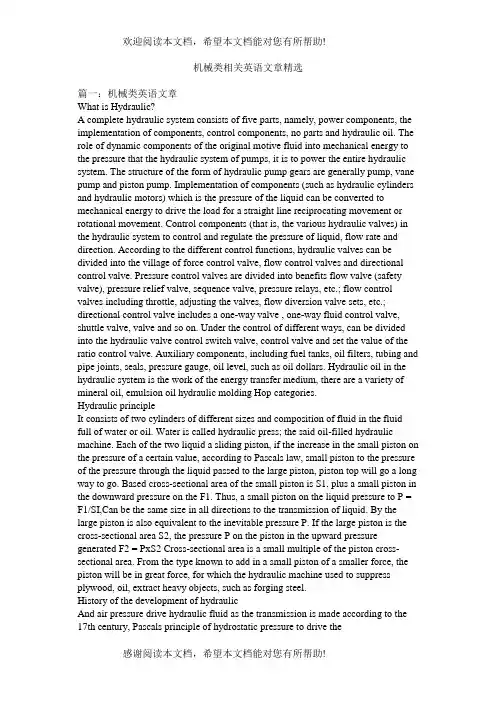
机械类相关英语文章精选篇一:机械类英语文章What is Hydraulic?A complete hydraulic system consists of five parts, namely, power components, the implementation of components, control components, no parts and hydraulic oil. The role of dynamic components of the original motive fluid into mechanical energy to the pressure that the hydraulic system of pumps, it is to power the entire hydraulic system. The structure of the form of hydraulic pump gears are generally pump, vane pump and piston pump. Implementation of components (such as hydraulic cylinders and hydraulic motors) which is the pressure of the liquid can be converted to mechanical energy to drive the load for a straight line reciprocating movement or rotational movement. Control components (that is, the various hydraulic valves) in the hydraulic system to control and regulate the pressure of liquid, flow rate and direction. According to the different control functions, hydraulic valves can be divided into the village of force control valve, flow control valves and directional control valve. Pressure control valves are divided into benefits flow valve (safety valve), pressure relief valve, sequence valve, pressure relays, etc.; flow control valves including throttle, adjusting the valves, flow diversion valve sets, etc.; directional control valve includes a one-way valve , one-way fluid control valve, shuttle valve, valve and so on. Under the control of different ways, can be divided into the hydraulic valve control switch valve, control valve and set the value of the ratio control valve. Auxiliary components, including fuel tanks, oil filters, tubing and pipe joints, seals, pressure gauge, oil level, such as oil dollars. Hydraulic oil in the hydraulic system is the work of the energy transfer medium, there are a variety of mineral oil, emulsion oil hydraulic molding Hop categories.Hydraulic principleIt consists of two cylinders of different sizes and composition of fluid in the fluid full of water or oil. Water is called hydraulic press; the said oil-filled hydraulic machine. Each of the two liquid a sliding piston, if the increase in the small piston on the pressure of a certain value, according to Pascals law, small piston to the pressure of the pressure through the liquid passed to the large piston, piston top will go a long way to go. Based cross-sectional area of the small piston is S1, plus a small piston in the downward pressure on the F1. Thus, a small piston on the liquid pressure to P = F1/SI,Can be the same size in all directions to the transmission of liquid. By the large piston is also equivalent to the inevitable pressure P. If the large piston is the cross-sectional area S2, the pressure P on the piston in the upward pressure generated F2 = PxS2 Cross-sectional area is a small multiple of the piston cross-sectional area. From the type known to add in a small piston of a smaller force, the piston will be in great force, for which the hydraulic machine used to suppress plywood, oil, extract heavy objects, such as forging steel.History of the development of hydraulicAnd air pressure drive hydraulic fluid as the transmission is made according to the 17th century, Pascals principle of hydrostatic pressure to drive thedevelopment of an emerging technology, the United Kingdom in 1795 Joseph (Joseph Braman ,1749-1814), in London water as a medium to form hydraulic press used in industry, the birth of the worlds first hydraulic press. Media work in 1905will be replaced by oil-water and further improved.World War I (1914-1918) after the extensive application of hydraulic transmission, especially after 1920, more rapid development. Hydraulic components in the late19th century about the early 20th century, 20 years, only started to enter the formal phase of industrial production. 1925 Vickers (F. Vikers) the invention of the pressure balanced vane pump, hydraulic components for the modern industrial or hydraulic transmission of the gradual establishment of the foundation. The early 20th century Constantine (G ? Constantimsco) fluctuations of the energy carried out by passing theoretical and practical research; in 1910 on the hydraulic transmission (hydraulic coupling, hydraulic torque converter, etc.) contributions, so that these two areas of development.The Second World War (1941-1945) period, in the United States 30% of machine tool applications in the hydraulic transmission. It should be noted that the development of hydraulic transmission in Japan than Europe and the United States and other countries for nearly 20 years later. Before and after in 1955, the rapid development of Japans hydraulic drive, set up in 1956, Hydraulic Industry. Nearly20 to 30 years, the development of Japans fast hydraulic transmission, a world leader. Hydraulic transmission There are many outstanding advantages, it is widely used, such as general workers. Plastic processing industry, machinery, pressure machinery, machine tools, etc.; operating machinery engineering machinery, construction machinery, agricultural machinery, automobiles, etc.; iron and steel industry metallurgical machinery, lifting equipment, such as roller adjustment device; civil water projects with flood control the dam gates and devices, bed lifts installations, bridges and other manipulation of institutions; speed turbine power plant installations, nuclear power plants, etc.; ship deck crane (winch), the bow doors, bulkhead valves, such as the stern thruster ; special antenna technology giant with control devices, measurement buoys, movements such as rotating stage;military-industrial control devices used in artillery, ship anti-rolling devices, aircraft simulation, aircraft retractable landing gear and rudder control devices and other devices.篇二:机械类专业英语文章翻译1.Chapter 2(P31)Unit2 Cast IronsIn order to understand the fabricating characteristics of cast irons, it is necessary to become familiar with the characteristics of the metal and the various types and classifications that are available.为了理解铸铁的制造特性,它是要熟悉的金属的特性和各种可用的类型和分类One of the distinguishing features of all irons is that they have a relatively high carbon content. Steels range up to about 2% carbon. Cast irons overlap with the steels somewhat and range from about 1.5% up to 5% carbon. It is principally the form of the carbon, with is governed by thermal conditions and alloying elements,that provides various structures that may be classified into the following main type:gray cast iron; white cast iron; ductile(nodular) graphite irons;compacted(vermicular) graphite iron.所有熨斗的一个显着特点是,它们具有相对高的碳含量。
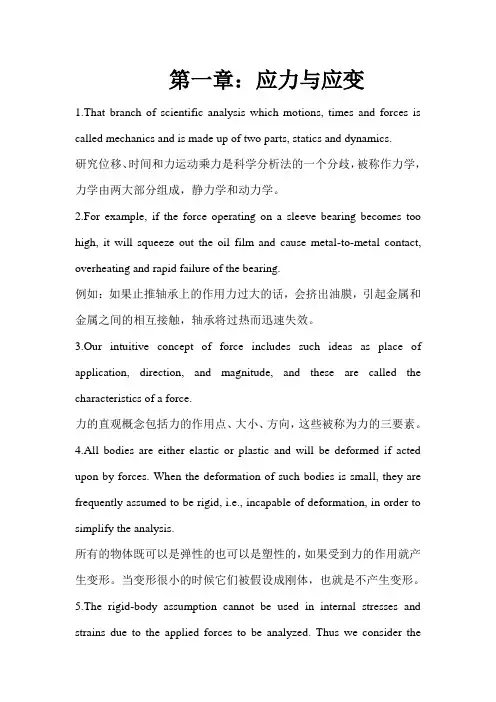
第一章:应力与应变1.That branch of scientific analysis which motions, times and forces is called mechanics and is made up of two parts, statics and dynamics.研究位移、时间和力运动乘力是科学分析法的一个分歧,被称作力学,力学由两大部分组成,静力学和动力学。
2.For example, if the force operating on a sleeve bearing becomes too high, it will squeeze out the oil film and cause metal-to-metal contact, overheating and rapid failure of the bearing.例如:如果止推轴承上的作用力过大的话,会挤出油膜,引起金属和金属之间的相互接触,轴承将过热而迅速失效。
3.Our intuitive concept of force includes such ideas as place of application, direction, and magnitude, and these are called the characteristics of a force.力的直观概念包括力的作用点、大小、方向,这些被称为力的三要素。
4.All bodies are either elastic or plastic and will be deformed if acted upon by forces. When the deformation of such bodies is small, they are frequently assumed to be rigid, i.e., incapable of deformation, in order to simplify the analysis.所有的物体既可以是弹性的也可以是塑性的,如果受到力的作用就产生变形。
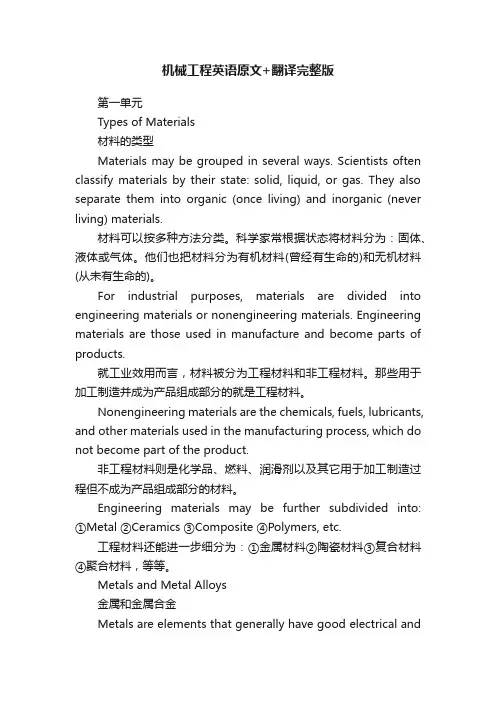
机械工程英语原文+翻译完整版第一单元Types of Materials材料的类型Materials may be grouped in several ways. Scientists often classify materials by their state: solid, liquid, or gas. They also separate them into organic (once living) and inorganic (never living) materials.材料可以按多种方法分类。
科学家常根据状态将材料分为:固体、液体或气体。
他们也把材料分为有机材料(曾经有生命的)和无机材料(从未有生命的)。
For industrial purposes, materials are divided into engineering materials or nonengineering materials. Engineering materials are those used in manufacture and become parts of products.就工业效用而言,材料被分为工程材料和非工程材料。
那些用于加工制造并成为产品组成部分的就是工程材料。
Nonengineering materials are the chemicals, fuels, lubricants, and other materials used in the manufacturing process, which do not become part of the product.非工程材料则是化学品、燃料、润滑剂以及其它用于加工制造过程但不成为产品组成部分的材料。
Engineering materials may be further subdivided into: ①Metal ②Ceramics ③Composite ④Polymers, etc.工程材料还能进一步细分为:①金属材料②陶瓷材料③复合材料④聚合材料,等等。
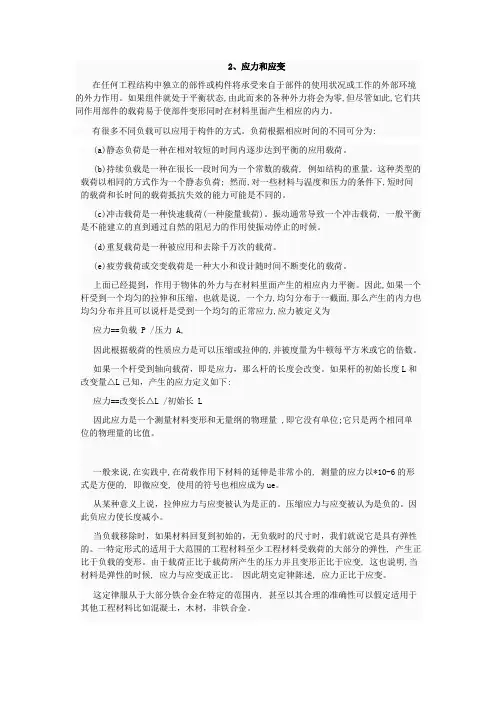
2、应力和应变在任何工程结构中独立的部件或构件将承受来自于部件的使用状况或工作的外部环境的外力作用。
如果组件就处于平衡状态,由此而来的各种外力将会为零,但尽管如此,它们共同作用部件的载荷易于使部件变形同时在材料里面产生相应的内力。
有很多不同负载可以应用于构件的方式。
负荷根据相应时间的不同可分为:(a)静态负荷是一种在相对较短的时间内逐步达到平衡的应用载荷。
(b)持续负载是一种在很长一段时间为一个常数的载荷, 例如结构的重量。
这种类型的载荷以相同的方式作为一个静态负荷; 然而,对一些材料与温度和压力的条件下,短时间的载荷和长时间的载荷抵抗失效的能力可能是不同的。
(c)冲击载荷是一种快速载荷(一种能量载荷)。
振动通常导致一个冲击载荷, 一般平衡是不能建立的直到通过自然的阻尼力的作用使振动停止的时候。
(d)重复载荷是一种被应用和去除千万次的载荷。
(e)疲劳载荷或交变载荷是一种大小和设计随时间不断变化的载荷。
上面已经提到,作用于物体的外力与在材料里面产生的相应内力平衡。
因此,如果一个杆受到一个均匀的拉伸和压缩,也就是说, 一个力,均匀分布于一截面,那么产生的内力也均匀分布并且可以说杆是受到一个均匀的正常应力,应力被定义为应力==负载 P /压力 A,因此根据载荷的性质应力是可以压缩或拉伸的,并被度量为牛顿每平方米或它的倍数。
如果一个杆受到轴向载荷,即是应力,那么杆的长度会改变。
如果杆的初始长度L和改变量△L已知,产生的应力定义如下:应力==改变长△L /初始长 L因此应力是一个测量材料变形和无量纲的物理量 ,即它没有单位;它只是两个相同单位的物理量的比值。
一般来说,在实践中,在荷载作用下材料的延伸是非常小的, 测量的应力以*10-6的形式是方便的, 即微应变, 使用的符号也相应成为ue。
从某种意义上说,拉伸应力与应变被认为是正的。
压缩应力与应变被认为是负的。
因此负应力使长度减小。
当负载移除时,如果材料回复到初始的,无负载时的尺寸时,我们就说它是具有弹性的。
机械类英语论文翻译.doc轴承内径 bearing bore diameter轴承寿命 bearing life轴承套圈 bearing ring轴承外径 bearing outside diameter轴颈 journal轴瓦、轴承衬 bearing bush轴端挡圈 shaft end ring轴环 shaft collar轴肩 shaft shoulder轴角 shaft angle轴向 axial direction轴向齿廓 axial tooth profile轴向当量动载荷 dynamic equivalent axial load轴向当量静载荷 static equivalent axial load轴向基本额定动载荷 basic dynamic axial load rating轴向基本额定静载荷 basic static axial load rating 轴向接触轴承 axial contact bearing轴向平面 axial plane轴向游隙 axial internal clearance轴向载荷 axial load轴向载荷系数 axial load factor轴向分力 axial thrust load主动件 driving link主动齿轮 driving gear主动带轮 driving pulley转动导杆机构 whitworth mechanism转动副 revolute (turning) pair转速 swiveling speed rotating speed转动关节 revolute joint转轴 revolving shaft转子 rotor转子平衡 balance of rotor装配条件 assembly condition锥齿轮 bevel gear锥顶 common apex of cone锥距 cone distance锥轮 bevel pulley; bevel wheel锥齿轮的当量直齿轮 equivalent spur gear of the bevel gear 锥面包络圆柱蜗杆 milled helicoids worm准双曲面齿轮 hypoid gear子程序 subroutine子机构 sub-mechanism自动化 automation自锁 self-locking自锁条件 condition of self-locking自由度 degree of freedom, mobility。
第一课Text:It is known that metals are very important in our life. Metals have the greatest importance for industry. All machines and other engineering[7endVi5niEriN] constructions have metal[5metl] parts; some of them consist only of metal parts.众所周知,金属在我们的生活中是非常重要的,金属对于工业而言是有巨大的重要性,所有机器和其他工程构造都有金属零部件,其中一些还只能由金属组成。
There are two large groups of metals:1) Simple metal- more or less pure chemical elements[5elimEnt]2) Alloys[5AlCi]- materials consisting of a simple metal combined with some other elements.有两大类金属:(1)纯金属——或多或少的金属元素(2)合金——组成纯金属的原料结合其他元素。
About two thirds of all elements found in the earth are metals, but not all metals may be used in industry. Those metals which are used in industry are called engineering metals. The most important engineering metalis iron[5aiEn], which in the form of alloys with carbon[5kB:bEn] and other elements, finds greater use than any other metal. Metals consisting of iron combined with some other elements are known as ferrous[5ferEs] metals; all the other metals are called nonferrous[5nCn5ferEs] metals. The most important nonferrous metal arecopper[5kCpE], aluminum[E5lju:minEm], lead[li:d], zinc[ziNk], tin[tin], but all these metals are used muchless than ferrous metals, because the ferrous metals are much cheaper.在地球上发现的所有元素中,大约三分之二是金属元素,但是并不是所有的金属都能够用于工业上。
第三课Overview of Engineering Mechanics工程力学概述当我们观察我们周围就会发现世界充满“物品”:机器,设备,工具;我们已经设计,建造,并使用的物品;木头,金属,陶瓷和塑料制品。
根据我们使用的经验知道,有些物品比其它物品更好;他们使用寿命较长,费用较低,噪音更低,更好看,或者更方便我们使用。
然而,在理想的情况下,每一件产品都是设计人员工具其对某些“功能要求”的理解而设计出来的,也就是说,在设计过程中,应该回答这样的问题,即“它应该具有哪种确切的功能?”在工程领域,主要功能通常是承受由于重力,惯性力,压力等作用的一些类型的载荷。
从我们居住房屋的梁到飞机机翼,都必须有一个适当的材料,尺寸,在较合理的寿命基础上具有较合理的成本并能可靠地完成其功能的产品结构连接的组合。
在实践中,工程力学方法常被应用在两个完全不同领域:(1) 任何新装置的研发都需要对其结构,尺寸,材料,载荷,耐久性,安全和成本的反复考虑。
(2) 当一个装置(意外地)发生失效后,通常需要进行研究,找出失效的原因,并找出潜在的纠正措施。
最好的设计往往都是不断排除薄弱环节的演变过程。
对许多工程师来说,上述过程既可以令人非常的陶醉又可以使人非常的愉快,更何况(有时)对我们是有利的。
对于任何实际的问题,总是缺乏足够完整和有用的信息。
我们很少准确地知道实际荷载和工作状态,因此,所做的分析工作也很少是精确的。
虽然我们的数学可以准确,全面的分析一般只能近似,而且不同技术水平的人能得到不同的解。
在工程力学研究领域,大多数问题要想得到唯一解就要充分的理想化,但应该清楚,“现实世界”远不非理想化程度,因此为了得到问题的解决方案不得不进行一些理想化假设。
我们要考虑的技术领域通常被称为“静力学”和“材料力学”,“静力学”,指的是研究作用在固定装置上的作用力,“材料力学”指的是施加到结构的力(变形,载荷限制等)的影响。
但是,事实上很多设备都不是静态的,如果与动力学有关的额外负荷被考虑了的话,那么静力学的研究方法完全适用于动态的情况,只要动态力相对静态载荷较小,系统通常被认为是静态的。
机械工程专业英语教程第一课:机械工程简介Introduction to Mechanical EngineeringSection 1: OverviewMechanical engineering is a diverse and dynamic field that encompasses the design, development, and operation of machinery, structures, and systems. This branch of engineering plays a crucial role in various industries, including automotive, aerospace, manufacturing, and energy.Section 2: Responsibilities and SkillsAs a mechanical engineer, your responsibilities will include designing and analyzing mechanical systems, conducting tests and experiments, and supervising the manufacturing process. You will also need to have a strong understanding of physics, mathematics, and computer-aided design (CAD). Additionally, problem-solving skills, attention to detail, and the ability to work well in teams are essential.Section 3: Career OpportunitiesA degree in mechanical engineering can open up a wide range of career opportunities. You could work in research and development, product design, manufacturing, or projectmanagement. Mechanical engineers are in demand in almost every industry, ensuring a stable and rewarding career path.Section 4: University CoursesTo become a mechanical engineer, it is essential to pursue a degree in mechanical engineering from a reputable university. The curriculum typically includes courses in engineering principles, materials science, thermodynamics, fluid mechanics, and mechanical design. Additionally, practical training through internships or cooperative education programs is crucial for gaining hands-on experience.Section 5: ConclusionMechanical engineering offers a challenging and rewarding career for those with a passion for solving problems and a desire to create innovative solutions. With the right education and skills, you can embark on a successful journey in the field of mechanical engineering. Remember, the possibilities are endless in this ever-evolving discipline.第二课:机械设计基础Fundamentals of Mechanical DesignSection 1: IntroductionIn this lesson, we will explore the fundamentals of mechanical design. Mechanical design involves the creation and development of physical systems and components that meet specific requirements and specifications. This processrequires a deep understanding of materials, mechanics, and engineering principles.Section 2: Design ProcessThe design process typically follows a systematic approach that includes several stages. These stages include problem identification, conceptual design, detailed design, manufacturing, and testing. Each stage involves various activities such as brainstorming, prototyping, and evaluation.Section 3: Design ConsiderationsDuring the design process, there are several important considerations to keep in mind. These include functionality, efficiency, reliability, safety, and cost-effectiveness. It is also crucial to consider the environmental impact and sustainability of the design.Section 4: Tools and SoftwareTo aid in the design process, engineers use various tools and software. Computer-aided design (CAD) software allows for precise modeling and simulation of mechanical systems. Finite element analysis (FEA) software helps in analyzing the structural integrity and performance of designs.Section 5: Case StudyTo further understand the application of mechanical design principles, we will examine a case study. This real-world example will demonstrate how the design process isimplemented to solve a specific problem and achieve desired outcomes.Section 6: ConclusionMechanical design is a critical aspect of mechanical engineering. It requires a combination of creativity, technical knowledge, and attention to detail. By mastering the fundamentals of mechanical design, you will be well-equippedto tackle complex challenges and contribute to the development of innovative solutions.以上是《机械工程专业英语教程》的课文翻译。
机械工程专业英语第二版康兰参考译文康兰简介康兰(Kanglan)是一位著名的机械工程专业翻译家,他为机械工程学科领域的英文文献提供了许多优秀的译文。
他的翻译作品以准确、流畅、专业而闻名,并且广泛被机械工程专业人士所引用和使用。
本文将为大家介绍康兰参考译文的第二版,其中涵盖了机械工程专业的各个领域。
译文内容康兰参考译文第二版涵盖了机械工程专业的许多重要内容,包括但不限于机械设计、机械制造、机械控制、热力学、流体力学等领域。
以下是其中的一些示例:1. 机械设计在机械设计方面,康兰参考译文第二版提供了一些经典的翻译作品,如《机械设计基础》、《机械元件设计》等。
这些译文涵盖了机械设计的基本原理、方法和技术,包括机械设计的概念、设计流程、设计计算等。
2. 机械制造在机械制造方面,康兰参考译文第二版涵盖了广泛的内容,包括数控机床、机械加工工艺、机械加工精度等。
这些译文详细介绍了机械制造的各个方面,从机械加工的基本原理到机床的结构与控制,让读者对机械制造有一个全面的了解。
3. 机械控制在机械控制方面,康兰参考译文第二版为读者提供了丰富的内容。
这些译文涵盖了机械控制的基本概念、控制器的设计原理、控制算法等。
通过阅读这些参考译文,读者可以了解到机械控制的基本理论和应用技术。
4. 热力学在热力学方面,康兰参考译文第二版提供了一些经典的翻译作品,如《工程热力学》、《热能转换与利用》等。
这些译文介绍了热力学的基本概念、热力学循环、热力学定律等,对于研究热力学和热能转换有着重要的参考价值。
5. 流体力学在流体力学方面,康兰参考译文第二版提供了一些重要的翻译作品,如《流体力学基础》、《流体力学与传热学》等。
这些译文详细介绍了流体力学的基本原理、流体力学方程、流体力学模型等,对于学习和研究流体力学具有重要的参考价值。
总结康兰参考译文第二版是机械工程专业英语领域的重要参考书籍,它涵盖了机械工程专业各个领域的重要内容。
通过阅读这些译文,读者可以深入了解机械工程的基本理论、方法和技术,并且能够在实际工作中运用所学知识。
机械专业英语词汇金属切削metal cutting机床machine tool金属工艺学technology of metals刀具cutter摩擦friction联结link传动drive/transmission轴shaft弹性elasticity频率特性frequency characteristic误差error响应response定位allocation机床夹具jig动力学dynamic运动学kinematic静力学static分析力学analyse mechanics拉伸pulling压缩hitting剪切shear扭转twist弯曲应力bending stress强度intensity三相交流电three-phase AC磁路magnetic circles变压器transformer异步电动机asynchronous motor几何形状geometrical精度precision正弦形的sinusoid交流电路AC circuit机械加工余量machining allowance变形力deforming force变形deformation应力stress硬度rigidity热处理heat treatment退火anneal正火normalizing脱碳decarburization渗碳carburization电路circuit半导体元件semiconductor element反馈feedback发生器generator直流电源DC electrical source门电路gate circuit逻辑代数logic algebra外圆磨削external grinding内圆磨削internal grinding平面磨削plane grinding变速箱gearbox离合器clutch绞孔fraising绞刀reamer螺纹加工thread processing螺钉screw铣削mill铣刀milling cutter功率power工件workpiece齿轮加工gear mechining齿轮gear主运动main movement主运动方向direction of main movement 进给方向direction of feed进给运动feed movement合成进给运动resultant movement of feed 合成切削运动resultant movement of cutting合成切削运动方向direction of resultant movement of cutting切削深度cutting depth前刀面rake face刀尖nose of tool前角rake angle后角clearance angle龙门刨削planing主轴spindle主轴箱headstock卡盘chuck2加工中心machining center车刀lathe tool车床lathe钻削镗削bore车削turning磨床grinder基准benchmark钳工locksmith锻forge压模stamping焊weld拉床broaching machine拉孔broaching装配assembling铸造found流体动力学fluid dynamics流体力学fluid mechanics加工machining液压hydraulic pressure切线tangent机电一体化mechanotronics mechanical-electrical integration气压air pressure pneumatic pressure 稳定性stability介质medium液压驱动泵fluid clutch液压泵hydraulic pump阀门valve失效invalidation强度intensity载荷load应力stress安全系数safty factor可靠性reliability螺纹thread螺旋helix键spline销pin滚动轴承rolling bearing滑动轴承sliding bearing弹簧spring制动器arrester brake十字结联轴节crosshead联轴器coupling链chain皮带strap精加工finish machining粗加工rough machining变速箱体gearbox casing腐蚀rust氧化oxidation磨损wear耐用度durability随机信号random signal离散信号discrete signal超声传感器ultrasonic sensor集成电路integrate circuit挡板orifice plate残余应力residual stress套筒sleeve扭力torsion冷加工cold machining电动机electromotor汽缸cylinder过盈配合interference fit热加工hotwork摄像头CCD camera倒角rounding chamfer优化设计optimal design工业造型设计industrial moulding design 有限元finite element滚齿hobbing插齿gear shaping伺服电机actuating motor铣床milling machine钻床drill machine镗床boring machine步进电机stepper motor丝杠screw rod导轨lead rail组件subassembly可编程序逻辑控制器Programmable Logic Controller PLC电火花加工electric spark machining电火花线切割加工electrical discharge wire - cutting相图phase diagram热处理heat treatment固态相变solid state phase changes有色金属nonferrous metal3陶瓷ceramics合成纤维synthetic fibre电化学腐蚀electrochemical corrosion 车架automotive chassis悬架suspension转向器redirector变速器speed changer板料冲压sheet metal parts孔加工spot facing machining车间workshop工程技术人员engineer气动夹紧pneuma lock数学模型mathematical model画法几何descriptive geometry机械制图Mechanical drawing投影projection视图view剖视图profile chart标准件standard component零件图part drawing装配图assembly drawing尺寸标注size marking技术要求technical requirements刚度rigidity内力internal force位移displacement截面section疲劳极限fatigue limit断裂fracture塑性变形plastic distortion脆性材料brittleness material刚度准则rigidity criterion垫圈washer垫片spacer直齿圆柱齿轮straight toothed spur gear 斜齿圆柱齿轮helical-spur gear直齿锥齿轮straight bevel gear运动简图kinematic sketch齿轮齿条pinion and rack蜗杆蜗轮worm and worm gear虚约束passive constraint曲柄crank摇杆racker凸轮cams共轭曲线conjugate curve范成法generation method定义域definitional domain值域range导数\\微分differential coefficient求导derivation定积分definite integral不定积分indefinite integral曲率curvature偏微分partial differential毛坯rough游标卡尺slide caliper千分尺micrometer calipers攻丝tap二阶行列式second order determinant 逆矩阵inverse matrix线性方程组linear equations概率probability随机变量random variable排列组合permutation and combination 气体状态方程equation of state of gas 动能kinetic energy势能potential energy机械能守恒conservation of mechanical energy动量momentum桁架truss轴线axes余子式cofactor逻辑电路logic circuit触发器flip-flop脉冲波形pulse shape数模digital analogy液压传动机构fluid drive mechanism 机械零件mechanical parts淬火冷却quench淬火hardening回火tempering调质hardening and tempering磨粒abrasive grain结合剂bonding agent砂轮grinding wheel机械零件mechanical parts淬火冷却quench淬火hardening回火tempering4调质hardening and tempering磨粒abrasive grain结合剂bonding agent砂轮grinding wheel机床行业部分英汉对照(1):按英文字母排序3-Jaws indexing spacers 三爪、分割工具头A.T.C.system 加工中心机刀库Aluminum continuous melting & holding fu rnaces 连续溶解保温炉Balancing equipment 平衡设备Bayonet 卡口Bearing fittings 轴承配件Bearing processing equipment 轴承加工机Bearings 轴承Belt drive 带传动Bending machines 弯曲机Blades 刀片Blades,saw 锯片Bolts,screws & nuts 螺栓,螺帽及螺丝Boring heads 搪孔头Boring machines 镗床Cable making tools 造线机Casting,aluminium 铸铝Casting,copper 铸铜Casting,gray iron 铸灰口铁Casting,malleable iron 可锻铸铁Casting,other 其他铸造Casting,steel 铸钢Chain drive 链传动Chain making tools 造链机Chamfer machines 倒角机Chucks 夹盘Clamping/holding systems 夹具/支持系统CNC bending presses 电脑数控弯折机CNC boring machines 电脑数控镗床CNC drilling machines 电脑数控钻床CNC EDM wire-cutting machines 电脑数控电火花线切削机CNC electric discharge machines 电脑数控电火花机CNC engraving machines 电脑数控雕刻机CNC grinding machines 电脑数控磨床CNC lathes 电脑数控车床CNC machine tool fittings 电脑数控机床配件CNC milling machines 电脑数控铣床CNC shearing machines 电脑数控剪切机CNC toolings CNC 刀杆CNC wire-cutting machines 电脑数控线切削机Conveying chains 输送链Coolers 冷却机Coupling 联轴器Crimping tools 卷边工具Cutters 刀具Cutting-off machines 切断机Diamond cutters 钻石刀具Dicing saws 晶圆切割机Die casting dies 压铸冲模Die casting machines 压铸机Dies-progressive 连续冲模Disposable toolholder bits 舍弃式刀头Drawing machines 拔丝机Drilling machines 钻床Drilling machines bench 钻床工作台Drilling machines,high-speed 高速钻床Drilling machines,multi-spindle 多轴钻床Drilling machines,radial 摇臂钻床Drilling machines,vertical 立式钻床drills 钻头Electric discharge machines(EDM) 电火花机Electric power tools 电动刀具Engraving machines 雕刻机Engraving machines,laser 激光雕刻机Etchin g machines 蚀刻机Finishing machines 修整机Fixture 夹具Forging dies 锻模Forging,aluminium 锻铝Forging,cold 冷锻Forging,copper 铜锻Forging,other 其他锻造Forging,steel 钢锻Foundry equipment 铸造设备Gear cutting machines 齿轮切削机5Gears 齿轮Gravity casting machines 重力铸造机Grinde r bench 磨床工作台Grinders,thread 螺纹磨床Grinders,tools & cutters 工具磨床Grinders,ultrasonic 超声波打磨机Grinding machines 磨床Grinding machines,centerless 无心磨床Grinding machines,cylindrical 外圆磨床Grinding machines,universal 万能磨床Grinding tools 磨削工具Grinding wheels 磨轮Hand tools 手工具Hard/soft and free expansion sheet making plant 硬(软)板(片)材及自由发泡板机组Heat preserving furnaces 保温炉Heating treatment funaces 熔热处理炉Honing machines 搪磨机Hydraulic components 液压元件Hydraulic power tools 液压工具Hydraulic power units 液压动力元件Hydra ulic rotary cylinders 液压回转缸Jigs 钻模Lapping machines 精研机Lapping machines,centerless 无心精研机Laser cutting 激光切割Laser cutting for SMT stensil 激光钢板切割机Lathe bench 车床工作台Lathes,automatic 自动车床Lathes,heavy-duty 重型车床Lathes,high-speed 高速车床Lathes,turret 六角车床Lathes,vertical 立式车床Lubricants 润滑液Lubrication Systems 润滑系统Lubricators 注油机Machining centers,general 通用加工中心Machining centers,horizontal 卧式加工中心Machining centers,horizontal & vertical 卧式及立式加工中心Machining centers,vertical 立式加工中心Machining centers,vertical double-column ty pe 立式双柱加工中心Magnetic tools 磁性工具Manifolds 集合管Milling heads 铣头Milling machines 铣床Milling machines,bed type 床身式铣床Milling machines,duplicating 仿形铣床Milling machines,horizontal 卧式铣床Millin g machines,turret vertical 六角立式铣床Milling machines,universal 万能铣床Milling machines,vertical 立式铣床Milling machines,vertical & horizontal 立式及卧式铣床Mold & die components 模具单元Mold changing systems 换模系统Mold core 模芯Mold heaters/chillers 模具加热器/冷却器Mold polishing/texturing 模具打磨/磨纹Mold repair 模具维修Molds 模具Nail making machines 造钉机Oil coolers 油冷却器Overflow cutting machines for aluminium w heels 铝轮冒口切断机P type PVC waterproof rolled sheet making plant P型PVC 高分子防水PCB fine piecing systems 印刷电器板油压冲孔脱料系统Pipe & tube making machines 管筒制造机Planing machines 刨床Planing machines vertical 立式刨床Pneumatic hydraulic clamps 气油压虎钳Pneumatic power tools 气动工具Powder metallurgic forming machines 粉末冶金成型机Presses,cold forging 冷锻冲压机presses,crank 曲柄压力机Presses,eccentric 离心压力机Presses,forging 锻压机Presses,hydraulic 液压冲床Presses,knuckle joint 肘杆式压力机Presses,pneumatic 气动冲床Presses,servo 伺服冲床Presses,transfer 自动压力机Pressing dies 压模Punch formers 冲子研磨器Quick die change systems 速换模系统6Quick mold change systems 快速换模系统Reverberatory furnaces 反射炉Rollers 滚筒Rolling machines 辗压机Rotary tables 转台Sawing machines 锯床Sawing machines,band 带锯床Saws,band 带锯Saws,hack 弓锯Saws,horizontal band 卧式带锯Saws,vertical band 立式带锯shafts 轴Shapers 牛头刨床Shearing machines 剪切机Sheet metal forming machines 金属板成型机Sheet metal working machines 金属板加工机Slotting machines 插床spindles 主轴Stamping parts 冲压机Straightening machines 矫直机Switches & buttons 开关及按钮Tapping machines 攻螺丝机Transmitted chains 传动链Tube bending machines 弯管机Vertical hydraulic broaching machine 立式油压拉床Vises 虎钳Vises,tool-maker 精密平口钳Wheel dressers 砂轮修整器Woven-Cutting machines 织麦激光切割机Wrenches 扳手螺丝词汇的中英文对照六角盖头螺帽HEX CAP NUTS六角锯齿螺帽HEX SERRATED NUTS六角轮缘螺帽HEX FLANGE NUTS 高脚螺帽HEX COUPLING NUTS(HIGH NUTS)圆螺帽ROUND NUTS四角螺帽SQUARE NUTS7HEA VY HEX NUTS不锈钢六角螺帽STAINLESS STEEL HEXNUTS不锈钢尼龙嵌入螺帽STAINLESS STEELNYLON INSERT LOCK NUTS普通六角螺帽HEX NUTS六角重型螺帽HEA VY HEX NUTS薄型螺帽HEX JAM NUTS尼龙嵌入防松螺帽NYLON INSERT LOCK NUTS 机械螺丝用六角螺帽HEX MACHINE SCREW NUT 机械工具英语机械工具spanner 扳子(美作:wrench) double-ended spanner 双头扳子adjustable spanner, monkey wrench 活扳子,活络扳手box spanner 管钳子(美作:socket wrench) calipers 卡规pincers, tongs 夹钳shears 剪子hacksaw 钢锯wire cutters 剪线钳multipurpose pliers,universal pliers 万能手钳adjustable pliers 可调手钳punch 冲子drill 钻chuck 卡盘scraper 三角刮刀reamer 扩孔钻callipergauge 孔径规rivet 铆钉nut 螺母locknut 自锁螺母,防松螺母bolt 螺栓pin, peg, dowel 销钉washer 垫圈staple U形钉oil can 油壶jack 工作服grease gun 注油枪机械加工抛光polishing 安装to assemble 衬套bushing外贸常用机械英语大全Assembly line 组装线Layout 布置图Conveyer 流水线物料板Rivet table 拉钉机Rivet gun 拉钉枪Screw driver 起子Pneumatic screw driver 气动起子worktable 工作桌OOBA 开箱检查fit together 组装在一起fasten 锁紧(螺丝)fixture 夹具(治具)pallet 栈板barcode 条码barcode scanner 条码扫描器fuse together 熔合fuse machine热熔机8repair修理operator作业员QC 品管supervisor 课长ME 制造工程师MT 制造生技cosmetic inspect 外观检查inner parts inspect 内部检查thumb screw 大头螺丝lbs. inch 镑、英寸EMI gasket 导电条front plate 前板rear plate 后板chassis 基座bezel panel 面板power button 电源按键reset button 重置键Hi-pot test of SPS 高源高压测试V oltage switch of SPS 电源电压接拉键sheet metal parts 冲件plastic parts 塑胶件SOP 制造作业程序material check list 物料检查表work cell 工作间trolley 台车carton 纸箱sub-line 支线left fork 叉车personnel resource department 人力资源部production department生产部门planning department企划部QC Section 品管科stamping factory冲压厂painting factory烤漆厂molding factory成型厂common equipment常用设备uncoiler and straightener整平机punching machine 冲床robot机械手hydraulic machine油压机lathe车床planer |plein|刨床miller 铣床grinder磨床linear cutting线切割electrical sparkle电火花welder电焊机staker=reviting machine铆合机position 职务president董事长general manager总经理special assistant manager特助factory director厂长department director部长deputy manager | =vice manager 副理sectio n supervisor课长deputy section supervisor =vice section supe risor副课长group leader/supervisor组长line supervisor线长assistant manager助理to move, to carry, to handle搬运be put in storage入库pack packing包装to apply oil 擦油to file burr 锉毛刺final inspection终检to connect material接料to reverse material 翻料wet station沾湿台Tiana天那水cleaning cloth抹布to load material上料to unload material卸料to return material/stock to退料scraped |\\'skr?pid|报废scrape ..v.刮;削deficient purchase来料不良manufacture procedure制程deficient manufacturing procedure制程不良oxidation |\\' ksi\\'dei?n|氧化scratch刮伤dents压痕defective upsiding down抽芽不良defective to staking铆合不良embedded lump镶块feeding is not in place送料不到位stamping-missing漏冲production capacity生产力education and training教育与训练9proposal improvement提案改善spare parts=buffer备件forklift叉车trailer=long vehicle拖板车外贸常用机械英语大全(续)compound die合模die locker锁模器pressure plate=plate pinch压板bolt 螺栓administration/general affairs dept总务部automatic screwdriver电动启子thickness gauge厚薄规gauge(or jig)治具power wire电源线buzzle蜂鸣器defective product label不良标签identifying sheet list 标示单location地点present members出席人员subject主题conclusion结论decision items决议事项responsible department负责单位pre-fixed finishing date预定完成日approved by / checked by / prepared by核准/ 审核/承办PCE assembly production schedule sheet PCE 组装厂生产排配表model 机锺work order工令revision版次remark备注production control confirmation生产确认checked by初审approved by核准department部门stock age analysis sheet 库存货龄分析表on-hand inventory现有库存available material良品可使用obsolete material良品已呆滞to be inspected or reworked 待验或重工total 合计cause description原因说明part number/ P/N 料号type形态item/group/class类别quality品质prepared by制表notes说明year-end physical inventory difference analysis sheet 年终盘点差异分析表physical inventory盘点数量physical count quantity帐面数量difference quantity差异量cause analysis原因分析raw materials原料materials物料finished product成品semi-finished product半成品packing materials包材good product/accepted goods/ acceptedparts/good parts良品defective product/non-good parts不良品disposed goods 处理品warehouse/hub仓库on way location在途仓oversea location海外仓spare parts physical inventory list备品盘点清单spare molds location模具备品仓skid/pallet 栈板tox machine自铆机wire EDM线割EDM放电机coil stock卷料sheet stock片料tolerance工差score=groove压线cam block滑块pilot 导正筒trim 剪外边pierce剪内边drag form压锻差pocket for the punch head挂钩槽slug hole 废料孔10feature die公母模expansion dwg展开图radius半径shim(wedge)楔子torch-flame cut火焰切割set screw止付螺丝form block折刀stop pin 定位销round pierce punch=die button圆冲子shape punch=die insert异形子stock locater block定位块under cut=scrap chopper清角active plate活动板baffle plate挡块cover plate盖板male die公模female die母模groove punch压线冲子air-cushion eject-rod气垫顶杆spring-box eject-plate弹簧箱顶板bushing block 衬套insert 入块club car高尔夫球车capability能力parameter参数factor系数phosphate皮膜化成viscosity涂料粘度alkalidipping脱脂main manifold主集流脉blanking穿落模dejecting顶固模demagnetization去磁;消磁high-speed transmission高速传递heat dissipation热传rack上料degrease脱脂rinse水洗alkaline etch龄咬desmut 剥黑膜D.I. rinse纯水次Chromate铬酸处理Anodize阳性处理seal封孔revision版次part number/P/N料号good products良品scraped products报放心品defective products不良品finished products成品disposed products处理品barcode条码flow chart流程表单assembly组装stamping冲压molding成型spare parts=buffer备品coordinate座标dismantle the die折模auxiliary fuction辅助功能poly-line多义线heater band 加热片thermocouple热电偶sand blasting喷沙grit 砂砾derusting machine除锈机degate打浇口dryer烘干机induction 感应induction light 感应光response=reaction=interaction感应ram连杆edge finder巡边器concave凸short 射料不足nick缺口speck瑕??shine亮班splay 银纹gas mark焦痕delamination起鳞cold slug冷块blush 导色gouge沟槽;凿槽satin texture段面咬花witness line证示线patent专利grit 沙砾granule=peuet=grain细粒11grit maker抽粒机cushion缓冲magnalium 镁铝合金magnesium镁金metal plate钣金lathe车mill 锉plane刨grind磨drill 铝boring镗blinster 气泡fillet 镶;嵌边through-hole form通孔形式voller pin formality滚针形式cam driver铡楔shank摸柄crank shaft曲柄轴augular offset角度偏差velocity速度production tempo生产进度现状torque扭矩spline=the multiple keys 花键quenching淬火tempering回火annealing退火carbonization碳化tungsten high speed steel钨高速的moly high speed steel钼高速的organic solvent有机溶剂bracket小磁导liaison 联络单volatile 挥发性resistance电阻ion 离子titrator滴定仪beacon警示灯coolant冷却液crusher破碎机机械类常用英语:生产类PCS Pieces 个(根,块等)PRS Pairs 双(对等)CTN Carton 卡通箱PAL Pallet/skid 栈板PO Purchasing Order 采购订单MO Manufacture Order 生产单D/C Date Code 生产日期码ID/C Identification Code (供应商)识别码SWR Special Work Request 特殊工作需求L/N Lot Number 批号P/N Part Number 料号阀门种类英汉术语对照Air valves 空气阀门Angle Stop valves 角式截止阀Angle Throttle Valves 角式节流阀Angle Type Globe Valves 门角式截止阀Ash valves 排灰阀Aspirating valves 吸(抽)气阀Auxiliary valves 辅助(副)阀Balance valves 平衡阀Bellows valves 波纹管阀Blowdown valves 泄料(放空,排污)阀Brake valves 制动阀Butterfly Type Non-slam Check 蝶式缓冲止回阀Butterfly Valves with Gear Actuator 蜗轮传动蝶阀Buttwelding valves 对焊连接阀Clamp valves 对夹式阀门Cock 二通Combination valves 组合阀CQ Thread Ball Valves CQ螺纹球阀Culvert valves 地下管道阀Deceleration valves 减速阀Diaphragm Valves 隔膜阀Decompression valves 泄压阀Double Disc Flat Gate Valves 双闸板平板闸阀Double Disk Parallel Gate V alves明杆平行式双闸板闸板Double Opening Exhaust Valves 双口排气球12Drainage valves 排水阀Electric Actuated Stop V alves 电动截止阀Electric Actuated Wedge Gate Valves 电动楔式闸阀Electric Double Disk Parallel Gate Valve s 电动平行式双闸板闸板Emergeny Cut-off Valves 紧急切断阀Exhaust valves 排气阀Free Float Type Steam Trap 浮球式疏水阀Flange Ball Valves 法兰球阀Flange Gate Valves 法兰闸阀Flange Globe Valves 法兰截止阀Gauge Valves 仪表阀Hand-operated valves 手动阀Hard Seal Butterfly Valves 金属密封碟阀High Temperature Pressure Power Statio n Gate Valves 高温高压电站闸阀High Temperature Pressure Power Statio n Globe Valves 高温高压电站截止阀Hydraulic relay valves 液压继动阀Lift Check Valves 升降式止回阀Lift Check Valves 升降式止回阀Limit valves 限位阀Lining Ball Valves 衬里球阀Lining Butterfly Valves 衬里碟阀Lining Check Valves 衬里止回阀Lining Cock 衬里二通Lining Globe Valves 衬里截止阀Lining T-Cock Valves 衬里三通旋塞阀Liquid Indicator 液位计LPG Pipe Fitting 液化气管件Magnetic Co-operate Globe Valves 磁耦合截止阀Magnetism Forle Pumps 磁力泵Manual Oil Pumps Valves 手摇油泵(阀) Meter Needle Type Globe Valves 仪表针形截止阀Oblique Stop Valves 直流式截止阀Parallel Slide Valves 浆液阀Pintle valve 针形阀Piping Centrifugal Pumps 管道离心泵Plunger valves 柱塞阀Pressure valve 压力(増压)阀Piping Pumps 管道泵Piping Safety Valves 管道安全阀Plunger Globe Valves 柱塞截止阀Quick Draining Valves 快速排污阀Restrictor Valves 过流阀(或节流阀) Safety Valves 安全阀Screw Pumps 螺杆泵Scum Gate Valves 排渣闸阀Solenoid valves 电磁阀Single Disc Flat Gate Valves 单闸板平板闸阀Single Opening Exhaust Valves 单口排气球Slurry Pumps 泥浆泵Stop Valves 截止阀Strainer 过滤器Submerged Motor Pumps 潜水电泵(排污泵)Swing Check Valves 旋启式止回阀Swing Check Valves 旋启式止回阀Tank Lorry Ball Valves 槽车球阀T-Cock 三通Thin Gate Valves 薄型闸阀Throttle Valves 节流阀Tiny Drag Slow Shut Check Valves 微阻缓闭止回阀Triple (tee) valves 三通阀Two-way valves 二通阀Under Water Pumps 液下泵Vacuum Pumps 水力喷射器(真空泵)Vertical Lift Check Valves 立式止回阀Wafer Check Valves 对夹式止回阀Wafer plate valves 对夹蝶板阀Wafer Type Butterfly Valves with Rubber Itning对夹式衬胶蝶阀Waste Valves 排污箱(阀)Water Seal Gate Valves 水封闸阀Wedge Gate Valves 楔式闸阀Y Type and Cylinder Filters Y型筒型过滤器阀门零部件英汉术语对照Axis Guide 轴套Ball 球、球芯13Ball seat 密封圈Blowdown Sealing Face 启、阀件密封面Body 阀体Bonnet 阀盖Disc 阀瓣Mut 螺母Screw 螺栓Sealing 密封件Spring 弹簧Stem 阀杆Stem Mut 阀杆螺母Stem seal 填料Wedge Disc 闸板阀门规范技术英语术语对照Applicable medium 适用介质Applicable temperature 适用温度Butt Clamp 对夹Chemical analysis 化学成份Connecting format 连接形式Double disc 双闸板Flexible disc 弹性闸板Flange 法兰Hoop 卡箍Inside thread 内螺纹Jacket 夹套Mains 电源Material chemical analysis and mechanical capacity材料化学成份和机械性能materials 材料Materials for main parts 主要零件材料Mechanical capacity 机械性能Max. Discharging Capacity 最大排水量Max. Operating Temperature 最高工作温度Max. Allowable Temperature 最高允许温度Max. Allowable Pressure 最高允许压力Model 型号Name of parts 零件名称nitrogen (N) 氮Nominal bore 公称通径Nominal Pressure 公称压力Nozzle 排气口Outside thread 外螺纹Oxidant 氧化性介质Parallel 平行Piping 管路Piston 活塞Reductant 还原性介质Rising stem 明杆Seal 阀座,密封面Seat testing pressure 压力气密封试验压力Socket 卡套Specifications 性能规范Single disc 单闸板Solid 刚性Strengh testing pressure 强度试验压力Steam , condensate 蒸汽,凝结水Stroke 冲程,行程Water,oil,steam 水,温度,气Wedge 楔式Welding 焊接阀门材质术语英汉对照Atbas metal 镍铬钢Buna-N rubber 丁晴橡胶Casting aluminium brass 铸铝黄铜Casting aluminium bronze 铸铝青铜Ceramic metal 陶瓷金属Chromel alloy 镍铬合金CHR rubber 氯晴橡胶Chrominm-molybdenum-vanadium steel 铬钼钒钢Chromium stainless steel 铬不锈钢Chromium-molybdenum steel 铬钼钢Corrugation pad 波形垫Cuprum alloy 铜合金Ductile Cast iron 球墨铸铁Expanded graphite 柔性石墨Fine Steel Casting iron 优质碳素钢Fluorous rubber 氟橡胶Gray Cast iron 灰铸铁Hayne's alloy 钴铬钨合金High tem perature steel 高温钢Monel 蒙乃尔合金Low temperature steel 低温钢Nylon 尼龙塑料Polytetrafluoroethylene(PTEF) 聚四氟乙烯Polythene 聚乙烯Pure aluminium 纯铝Pure cupper 纯铜14Rubber graphite board 橡胶石墨板Spring steel 弹簧钢Stainless acid-resisting steel 不锈耐酸钢Stainless and Graphite 不锈钢/石墨Stainless steel 不锈钢Steel Casting iron 碳素钢铸件Shell Test Pressure 壳体试验压力Service Fluid 工作介质机械类常用英语:钢材类alloy tool steel 合金工具钢aluminium allo y 铝合金钢bearing alloy 轴承合金blister steel 浸碳钢bonderized steel sheet 邦德防蚀钢板carbon tool steel 碳素工具钢clad sheet 被覆板clod work die steel 冷锻模用钢emery 金钢砂ferrostatic pressure 钢铁水静压力forging die steel 锻造模用钢galvanized ste el sheet 镀锌铁板hard alloy steel 超硬合金钢high speed too l steel 高速度工具钢hot work die steel 热锻模用钢low alloy to ol steel 特殊工具钢low manganese casting steel 低锰铸钢marg ing steel 马式体高强度热处理钢martrix alloy 马特里斯合金meehanite castiron 米汉纳铸钢meehanite metal 米汉纳铁merchant iron 市售钢材molybdenum high speed steel 钼系高速钢molybdenum steel 钼钢nickel chromium steel 镍铬钢prehardened steel 顶硬钢silicon steel sheet 矽钢板stainless steel 不锈钢tin plated steel sheet 镀锡铁板tough pitch copper 韧铜troostite 吐粒散铁tungsten steel ?钢vinyl tapped steel sheet 塑胶覆面钢板塑件模具相关英文compre sion molding压缩成型flash mold 溢流式模具plsitive mold 挤压式模具split mold 分割式模具cavity型控母模core模心公模taper锥拔leather cloak仿皮革shiver饰纹flow mark流痕welding mark溶合痕post screw insert螺纹套筒埋值self tapping screw自攻螺丝striper plate脱料板piston 活塞cylinder汽缸套chip细碎物handle mold手持式模具encapsulation molding低压封装成型、射出成型用模具two plate两极式(模具)well type蓄料井insulated runner绝缘浇道方式hot runner热浇道runner plat浇道模块valve gate阀门浇口band heater环带状的电热器spindle 阀针spear head刨尖头slag well冷料井cold slag冷料渣air vent排气道welding line熔合痕eject pin顶出针knock pin顶出销return pin回位销反顶针sleave套筒stripper plate脱料板insert core放置入子runner stripper plate浇道脱料板15guide pin 导销eject rod (bar)(成型机)顶业捧subzero深冷处理three plate三极式模具runner system浇道系统stress crack应力电裂orientation定向sprue gate射料浇口,直浇口nozzle射嘴sprue lock pin料头钩销(拉料杆) slag well冷料井side gate侧浇口edge gate侧缘浇口tab gate搭接浇口film gate薄膜浇口flash gate闸门浇口slit gate 缝隙浇口fan gate扇形浇口dish gate因盘形浇口diaphragm gate隔膜浇口ring gate环形浇口subarine gate潜入式浇口tunnel gate隧道式浇口pin gate针点浇口Runner less无浇道(sprue less)无射料管方式long nozzle 延长喷嘴方式sprue浇口;溶渣机械工程专业英语翻译第一课机械工程专业英语概述English in Mechanical Engineering一、专业英语概述1. 什么是翻译:翻译就是将一种语言文字的意义用另一种语言文字表达出来。